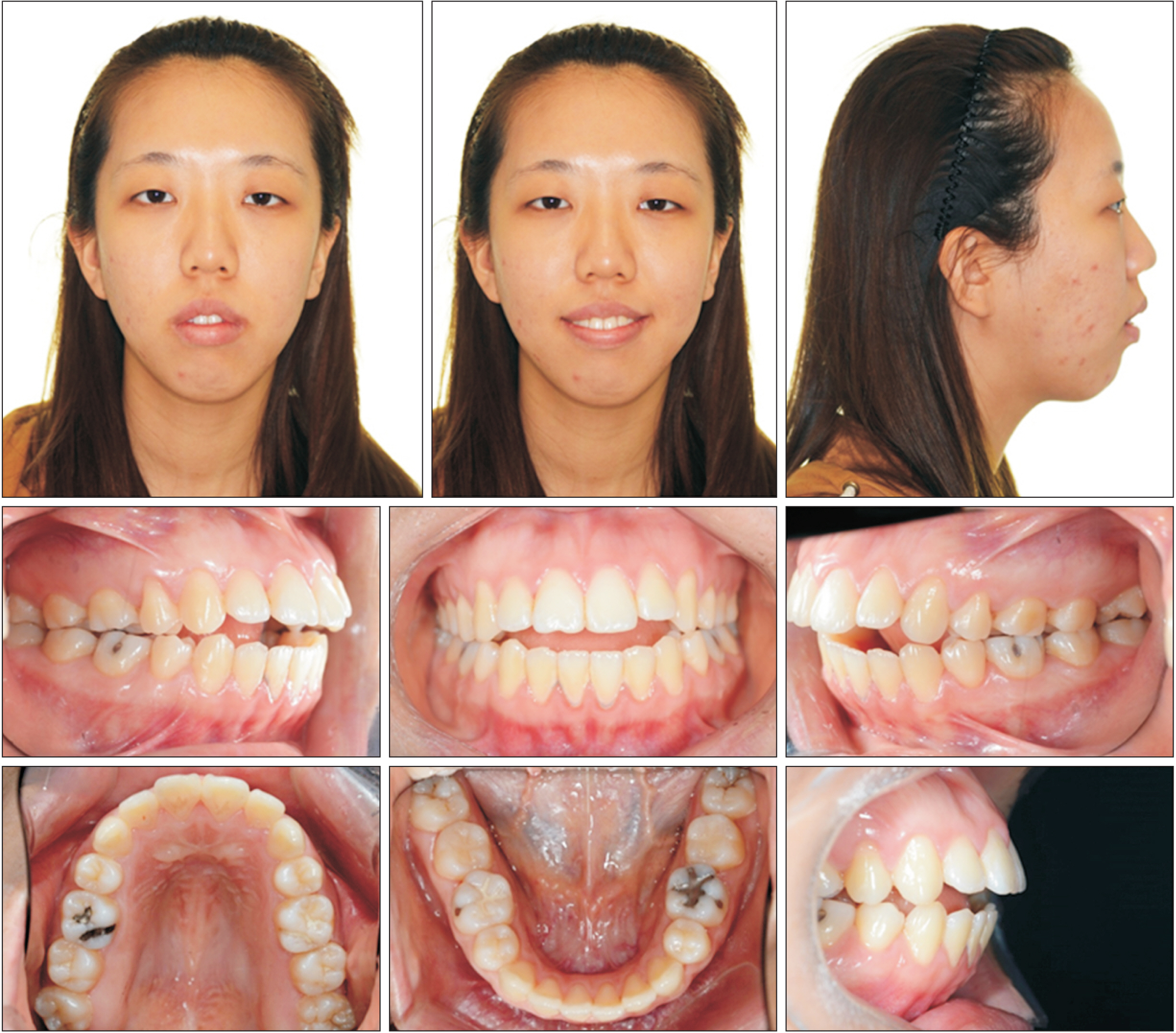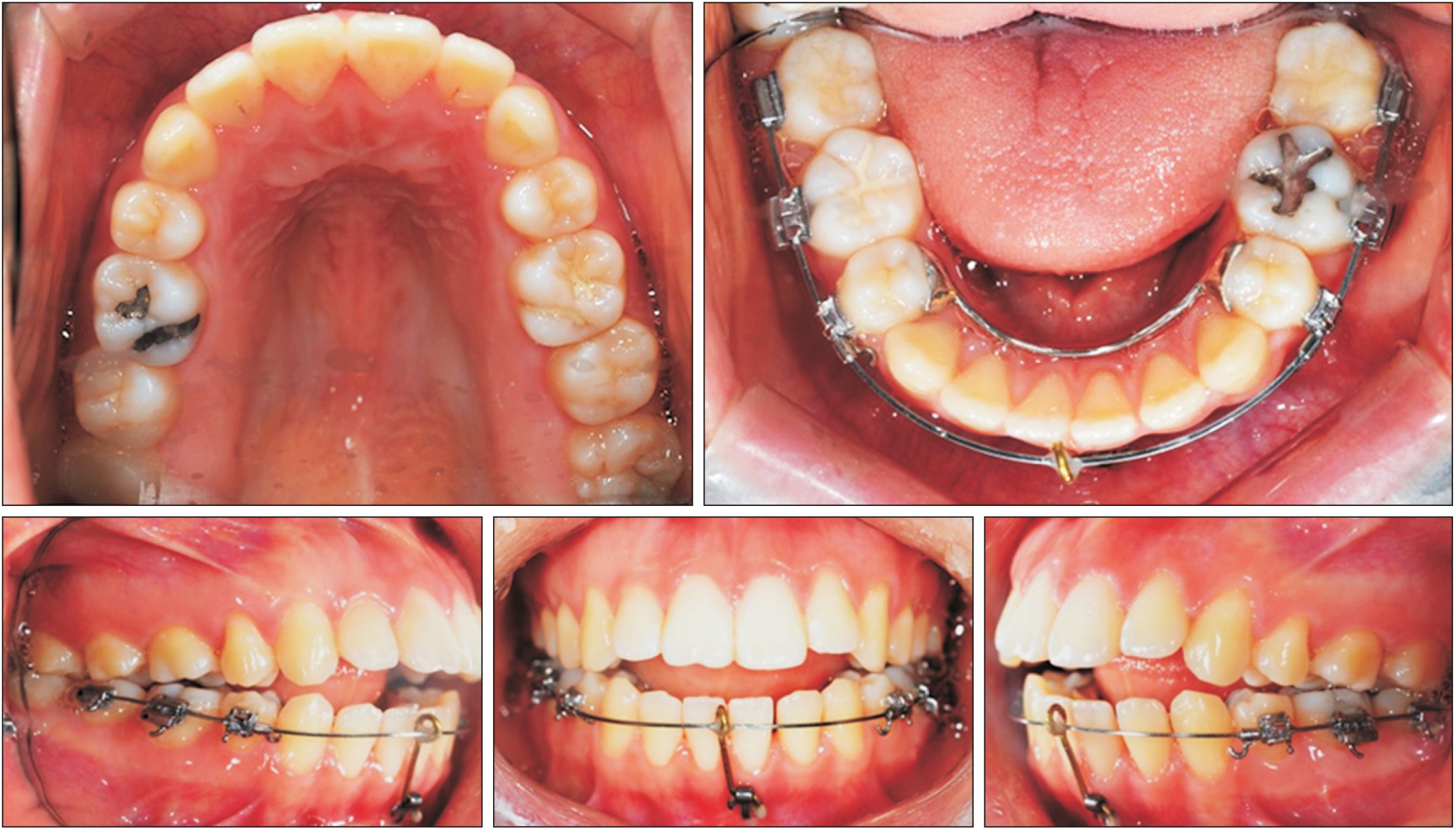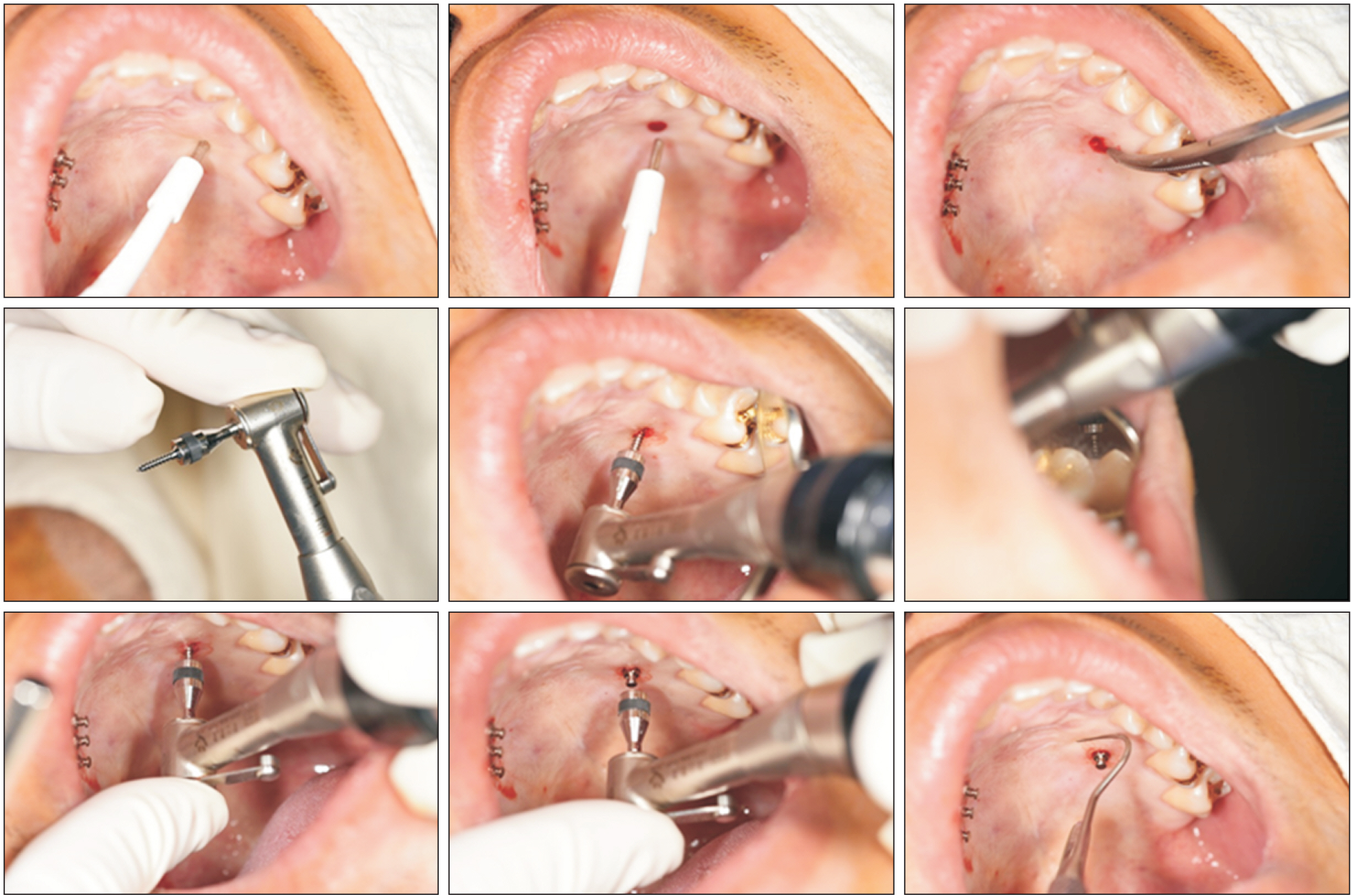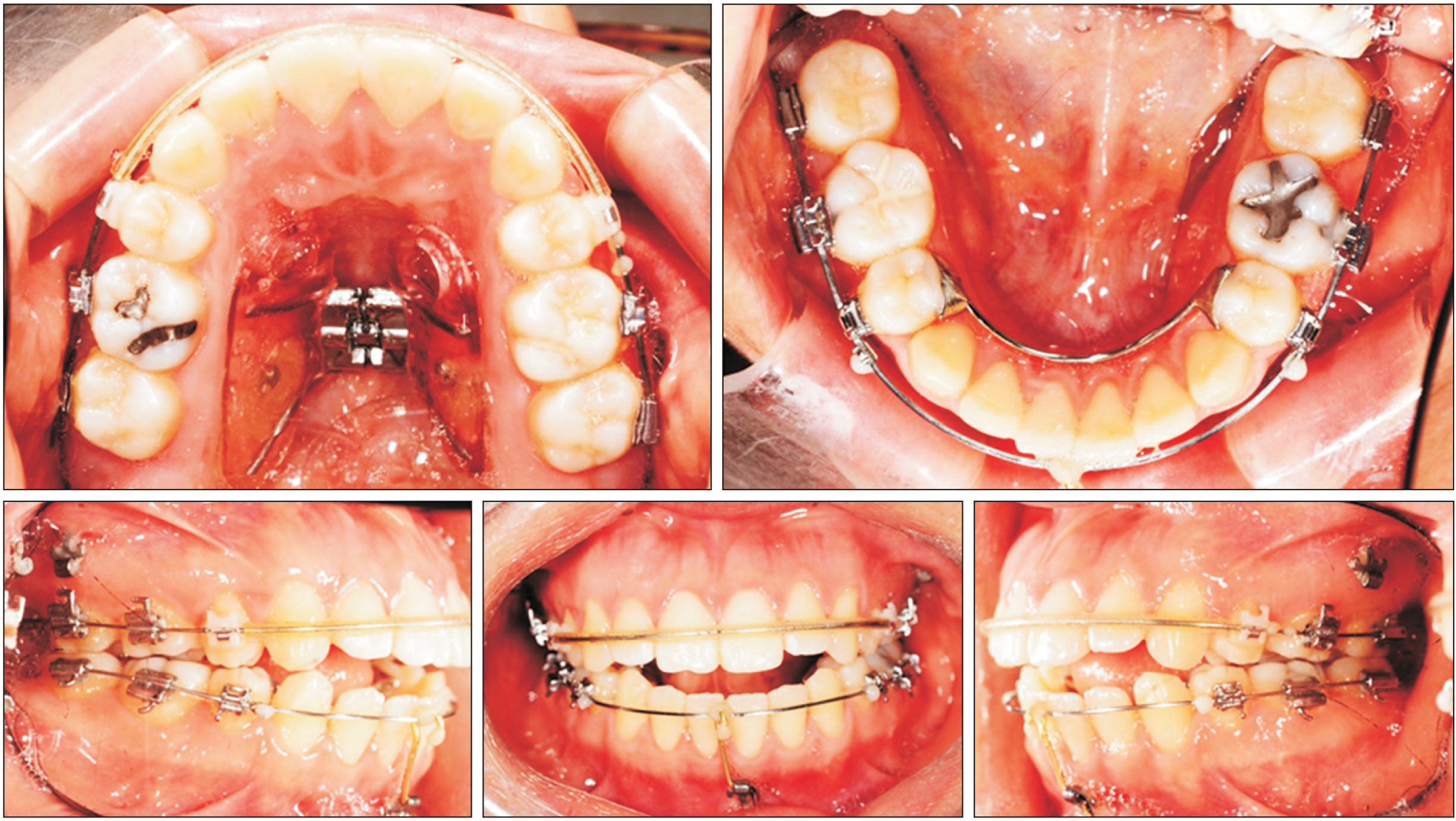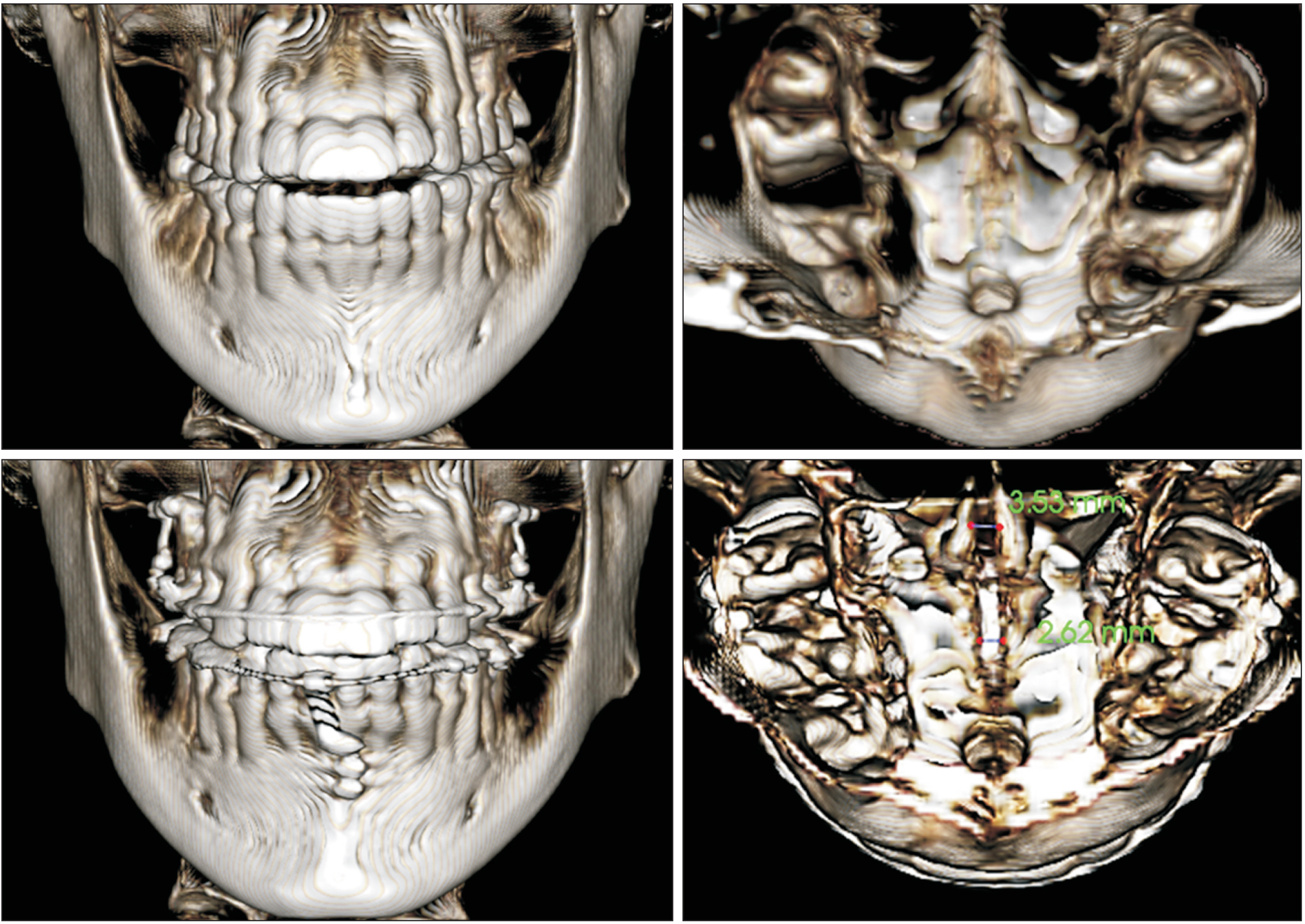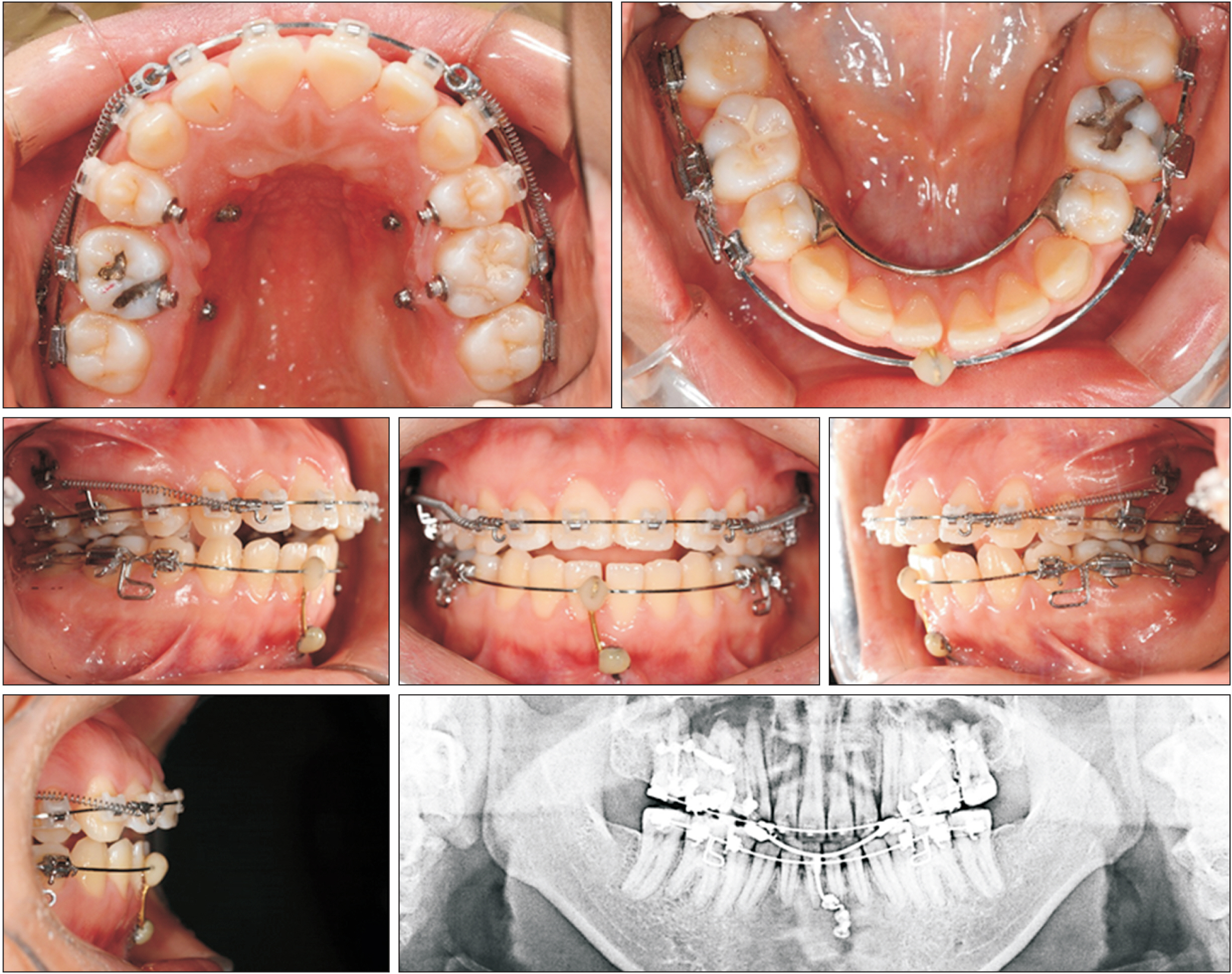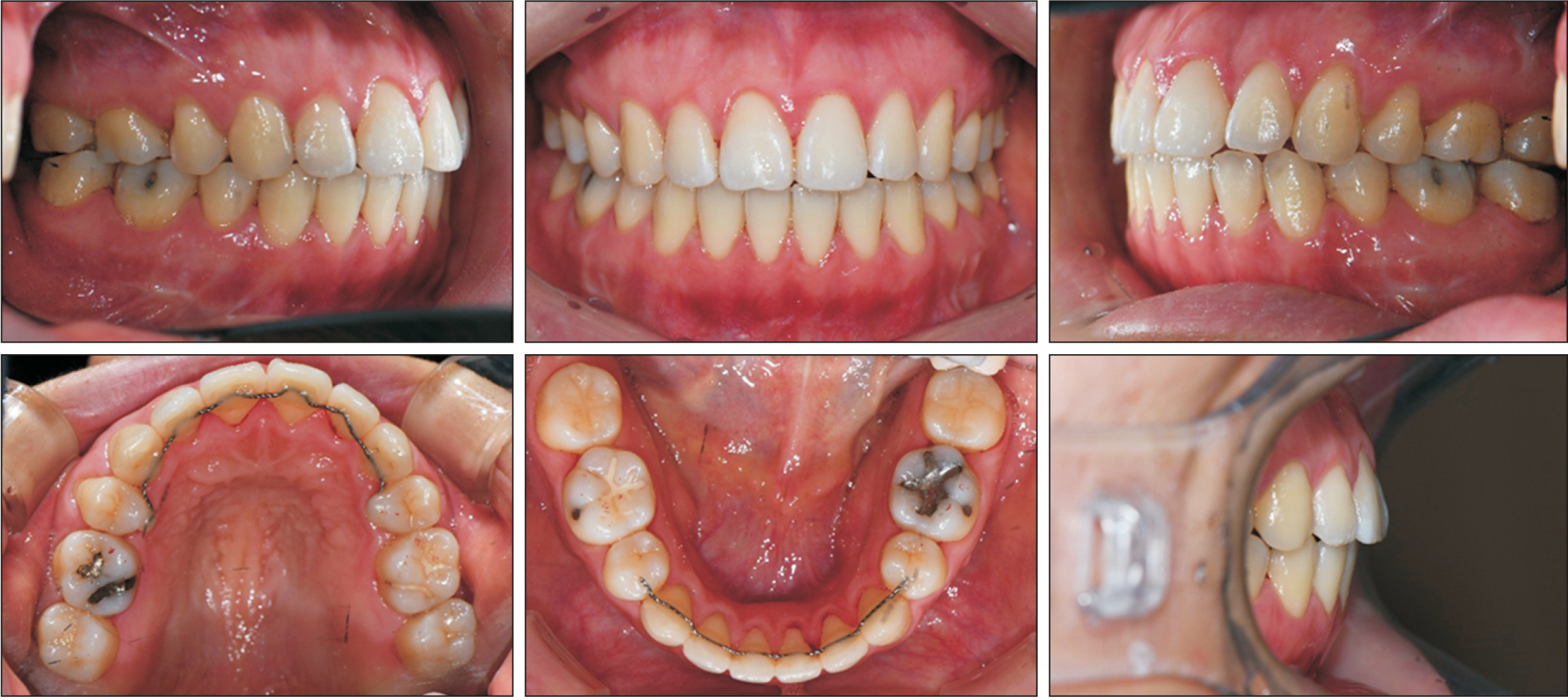Korean J Orthod.
2022 Sep;52(5):372-382. 10.4041/kjod22.158.
Clinical application of maxillary tissue bone-borne expander and biocreative reverse curve system in the orthodontic retreatment of severe anterior open bite with transverse discrepancy: A case report
- Affiliations
-
- 1Department of Orthodontics, Graduate School, Kyung Hee University, Seoul, Korea
- KMID: 2533262
- DOI: http://doi.org/10.4041/kjod22.158
Abstract
- Anterior open bite and transverse discrepancy are often accompanied by hyperdivergent skeletal patterns. In addition, degenerative joint disorders and vertical maxillary excess contribute to an unfavorable convex facial profile with a retruded chin. Correction of this complex three-dimensional problem with orthodontic treatment alone is considered challenging owing to anatomical limitations. Moreover, a history of orthodontic treatment with premolar extraction makes retreatment difficult. This case report illustrates the application of a maxillary tissue bone-borne expander and biocreative reverse curve system in a 23-year-old female patient with a severe anterior open bite and transverse discrepancy who underwent orthodontic treatment with four premolar extractions. By setting the treatment target under precise diagnosis and using appropriate appliances, a satisfactory treatment result could be achieved without orthognathic surgery.
Figure
Reference
-
1. Lopez-Gavito G, Wallen TR, Little RM, Joondeph DR. 1985; Anterior open-bite malocclusion: a longitudinal 10-year postretention evaluation of orthodontically treated patients. Am J Orthod. 87:175–86. DOI: 10.1016/0002-9416(85)90038-7. PMID: 3856391. PMID: https://www.scopus.com/inward/record.uri?partnerID=HzOxMe3b&scp=0022034309&origin=inward.2. Suh H, Garnett BS, Mahood K, Mahjoub N, Boyd RL, Oh H. 2022; Treatment of anterior open bites using non-extraction clear aligner therapy in adult patients. Korean J Orthod. 52:210–9. DOI: 10.4041/kjod21.180. PMID: 35527369. PMCID: PMC9117790. PMID: https://www.scopus.com/inward/record.uri?partnerID=HzOxMe3b&scp=85130796951&origin=inward.3. Greenlee GM, Huang GJ, Chen SS, Chen J, Koepsell T, Hujoel P. 2011; Stability of treatment for anterior open-bite malocclusion: a meta-analysis. Am J Orthod Dentofacial Orthop. 139:154–69. DOI: 10.1016/j.ajodo.2010.10.019. PMID: 21300243. PMID: https://www.scopus.com/inward/record.uri?partnerID=HzOxMe3b&scp=79551707765&origin=inward.4. González Espinosa D, de Oliveira Moreira PE, da Sousa AS, Flores-Mir C, Normando D. 2020; Stability of anterior open bite treatment with molar intrusion using skeletal anchorage: a systematic review and meta-analysis. Prog Orthod. 21:35. DOI: 10.1186/s40510-020-00328-2. PMID: 32888097. PMCID: PMC7474024. PMID: a91612bfb3a442b38c7e6d75ab4cdad8. PMID: https://www.scopus.com/inward/record.uri?partnerID=HzOxMe3b&scp=85090276369&origin=inward.5. Alsafadi AS, Alabdullah MM, Saltaji H, Abdo A, Youssef M. 2016; Effect of molar intrusion with temporary anchorage devices in patients with anterior open bite: a systematic review. Prog Orthod. 17:9. DOI: 10.1186/s40510-016-0122-4. PMID: 26980200. PMCID: PMC4803715. PMID: https://www.scopus.com/inward/record.uri?partnerID=HzOxMe3b&scp=85007440202&origin=inward.6. Kuroda S, Sakai Y, Tamamura N, Deguchi T, Takano-Yamamoto T. 2007; Treatment of severe anterior open bite with skeletal anchorage in adults: comparison with orthognathic surgery outcomes. Am J Orthod Dentofacial Orthop. 132:599–605. DOI: 10.1016/j.ajodo.2005.11.046. PMID: 18005833. PMID: https://www.scopus.com/inward/record.uri?partnerID=HzOxMe3b&scp=34547675229&origin=inward.7. Erverdi N, Keles A, Nanda R. 2004; The use of skeletal anchorage in open bite treatment: a cephalometric evaluation. Angle Orthod. 74:381–90. DOI: 10.1043/0003-3219(2004)074<0381:TUOSAI>2.0.CO;2. PMID: 15264651.8. Lin L, Ahn HW, Kim SJ, Moon SC, Kim SH, Nelson G. 2015; Tooth-borne vs bone-borne rapid maxillary expanders in late adolescence. Angle Orthod. 85:253–62. DOI: 10.2319/030514-156.1. PMID: 25490552. PMCID: PMC8631879. PMID: https://www.scopus.com/inward/record.uri?partnerID=HzOxMe3b&scp=84924918691&origin=inward.9. Seo YJ, Chung KR, Kim SH, Nelson G. 2015; Camouflage treatment of skeletal class III malocclusion with asymmetry using a bone-borne rapid maxillary expander. Angle Orthod. 85:322–34. DOI: 10.2319/031314-189.1. PMID: 25032737. PMCID: PMC8631886. PMID: https://www.scopus.com/inward/record.uri?partnerID=HzOxMe3b&scp=84924914857&origin=inward.10. Oh SH, Lee SR, Choi JY, Ahn HW, Kim SH, Nelson G. 2021; Geometry of anchoring miniscrew in the lateral palate that support a tissue bone borne maxillary expander affects neighboring root damage. Sci Rep. 11:19880. DOI: 10.1038/s41598-021-99442-2. PMID: 34615963. PMCID: PMC8494793. PMID: bf0d13e97131447aa3a60265ef072a3b. PMID: https://www.scopus.com/inward/record.uri?partnerID=HzOxMe3b&scp=85116454103&origin=inward.11. Elms TN, Buschang PH, Alexander RG. 1996; Long-term stability of Class II, Division 1, nonextraction cervical face-bow therapy: II. Cephalometric analysis. Am J Orthod Dentofacial Orthop. 109:386–92. DOI: 10.1016/S0889-5406(96)70120-8. PMID: 8638580. PMID: https://www.scopus.com/inward/record.uri?partnerID=HzOxMe3b&scp=0030117224&origin=inward.12. Roberts WW 3rd, Chacker FM, Burstone CJ. 1982; A segmental approach to mandibular molar uprighting. Am J Orthod. 81:177–84. DOI: 10.1016/0002-9416(82)90051-3. PMID: 6960706. PMID: https://www.scopus.com/inward/record.uri?partnerID=HzOxMe3b&scp=0020103549&origin=inward.13. Simon RL. 1984; Rationale and practical technique for uprighting mesially inclined molars. J Prosthet Dent. 52:256–9. DOI: 10.1016/0022-3913(84)90107-0. PMID: 6381712. PMID: https://www.scopus.com/inward/record.uri?partnerID=HzOxMe3b&scp=0021471166&origin=inward.14. Capelluto E, Lauweryns I. 1997; A simple technique for molar uprighting. J Clin Orthod. 31:119–25. PMID: 9511534.15. Kim YH. 1987; Anterior openbite and its treatment with multiloop edgewise archwire. Angle Orthod. 57:290–321. DOI: 10.1043/0003-3219(1987)057<0290:AOAITW>2.0.CO;2. PMID: 3479033.16. Motokawa M, Sasamoto T, Kaku M, Kawata T, Matsuda Y, Terao A, et al. 2012; Association between root resorption incident to orthodontic treatment and treatment factors. Eur J Orthod. 34:350–6. DOI: 10.1093/ejo/cjr018. PMID: 21811005. PMID: https://www.scopus.com/inward/record.uri?partnerID=HzOxMe3b&scp=84861643247&origin=inward.17. Ahn HW, Noh MK, Chung KR, Kim SH, Nelson G. 2020; Strategic molar uprighting using the biocreative reverse-curve technique. J Clin Orthod. 54:486–94. PMID: 32966268. PMID: https://www.scopus.com/inward/record.uri?partnerID=HzOxMe3b&scp=85091547886&origin=inward.18. Park JH, Choo H, Choi JY, Chung KR, Kim SH. 2021; Evaluation of strategic uprighting of the mandibular molars using an orthodontic miniplate and a nickel-titanium reverse curve arch wire: preliminary cephalometric study. Korean J Orthod. 51:179–88. DOI: 10.4041/kjod.2021.51.3.179. PMID: 33984225. PMCID: PMC8133900. PMID: https://www.scopus.com/inward/record.uri?partnerID=HzOxMe3b&scp=85107188877&origin=inward.19. Choi YJ, Kim DJ, Nam J, Chung CJ, Kim KH. 2016; Cephalometric configuration of the occlusal plane in patients with anterior open bite. Am J Orthod Dentofacial Orthop. 149:391–400. DOI: 10.1016/j.ajodo.2015.08.020. PMID: 26926027. PMID: https://www.scopus.com/inward/record.uri?partnerID=HzOxMe3b&scp=84959421653&origin=inward.20. Moon HW, Kim MJ, Ahn HW, Kim SJ, Kim SH, Chung KR, et al. 2020; Molar inclination and surrounding alveolar bone change relative to the design of bone-borne maxillary expanders: A CBCT study. Angle Orthod. 90:13–22. DOI: 10.2319/050619-316.1. PMID: 31461306. PMCID: PMC8087056. PMID: https://www.scopus.com/inward/record.uri?partnerID=HzOxMe3b&scp=85077404269&origin=inward.21. Park KH, Choi JY, Kim KA, Kim SJ, Chung KR, Kim SH. 2021; Critical issues concerning biocreative strategy in contemporary temporary skeletal anchorage device orthodontics: a narrative review. Orthod Craniofac Res. 24 Suppl 1:39–47. DOI: 10.1111/ocr.12444. PMID: 33237622. PMID: https://www.scopus.com/inward/record.uri?partnerID=HzOxMe3b&scp=85097227935&origin=inward.22. Park JH, Choi JY, Kim SH, Kim SJ, Lee KJ, Nelson G. 2021; Three-dimensional evaluation of the transfer accuracy of a bracket jig fabricated using computer-aided design and manufacturing to the anterior dentition: an in vitro study. Korean J Orthod. 51:375–86. DOI: 10.4041/kjod.2021.51.6.375. PMID: 34803026. PMCID: PMC8607117. PMID: https://www.scopus.com/inward/record.uri?partnerID=HzOxMe3b&scp=85114110627&origin=inward.23. Kim JW, Choi JY, Kim MJ, Bin X, Kim SH. 2022; A cone-beam computed tomography study on strategic uprighting of mandibular molars using a biocreative reverse curve system. Korean J Orthod. 52:354–61. DOI: 10.4041/kjod22.140. PMID: 36148642.24. Kim KY, Ahn HW, Kim SH, Nelson G. 2017; Effects of a new type of clear overlay retainer on occlusal contacts. Korean J Orthod. 47:207–12. DOI: 10.4041/kjod.2017.47.3.207. PMID: 28523247. PMCID: PMC5432442. PMID: https://www.scopus.com/inward/record.uri?partnerID=HzOxMe3b&scp=85032449220&origin=inward.25. Klontz HA. 1996; Tweed-Merrifield sequential directional force treatment. Semin Orthod. 2:254–67. DOI: 10.1016/S1073-8746(96)80025-9. PMID: 9161296. PMID: https://www.scopus.com/inward/record.uri?partnerID=HzOxMe3b&scp=0030325727&origin=inward.26. Cho HN, Yoon HJ, Park JH, Park YG, Kim SJ. 2021; Effect of extraction treatment on upper airway dimensions in patients with bimaxillary skeletal protrusion relative to their vertical skeletal pattern. Korean J Orthod. 51:166–78. DOI: 10.4041/kjod.2021.51.3.166. PMID: 33984224. PMCID: PMC8133903. PMID: https://www.scopus.com/inward/record.uri?partnerID=HzOxMe3b&scp=85107354591&origin=inward.27. Torres HM, Valladares-Neto J, Torres ÉM, Freitas RZ, Silva MA. 2017; Effect of genioplasty on the pharyngeal airway space following maxillomandibular advancement surgery. J Oral Maxillofac Surg. 75:189.e1–189.e12. DOI: 10.1016/j.joms.2016.09.005. PMID: 27728776. PMID: https://www.scopus.com/inward/record.uri?partnerID=HzOxMe3b&scp=85005943349&origin=inward.28. Lim LI, Choo H, Eto LF, Chung KR, Kim SH. 2022; Bio-Exercise (BioEx) - a biocreative orofacial myofunctional therapy: preliminary cephalometric study and clinical application. Dental Press J Orthod. 27:e2220367. DOI: 10.1590/2177-6709.27.2.e2220367.oar. PMID: 35613244. PMCID: PMC9128808. PMID: https://www.scopus.com/inward/record.uri?partnerID=HzOxMe3b&scp=85131106107&origin=inward.
- Full Text Links
- Actions
-
Cited
- CITED
-
- Close
- Share
- Similar articles
-
- A case report of orthodontic treatment of anterior open bite
- Treatment of anterior open bite by posterior maxillary segmental osteotomy and miniplates: a case report
- Reports of mandibular symphysis widening with distraction osteogenesis
- Treatment in Bimaxillary Prognathism with Anterior Open Bite: A Case Report
- Anterior Open Bite with Temporomandibular Joint Osteoarthritis Treated with Skeletal Anchorage Device: A Case Report

